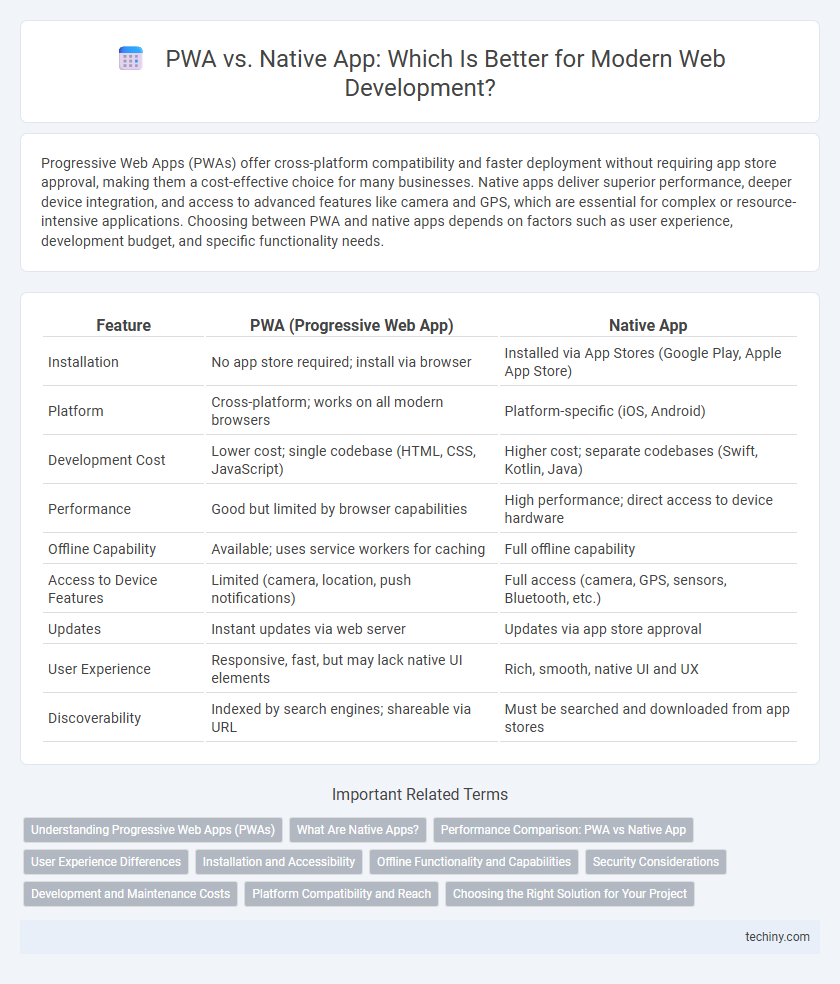Progressive Web Apps (PWAs) offer cross-platform compatibility and faster deployment without requiring app store approval, making them a cost-effective choice for many businesses. Native apps deliver superior performance, deeper device integration, and access to advanced features like camera and GPS, which are essential for complex or resource-intensive applications. Choosing between PWA and native apps depends on factors such as user experience, development budget, and specific functionality needs.
Table of Comparison
| Feature | PWA (Progressive Web App) | Native App |
|---|---|---|
| Installation | No app store required; install via browser | Installed via App Stores (Google Play, Apple App Store) |
| Platform | Cross-platform; works on all modern browsers | Platform-specific (iOS, Android) |
| Development Cost | Lower cost; single codebase (HTML, CSS, JavaScript) | Higher cost; separate codebases (Swift, Kotlin, Java) |
| Performance | Good but limited by browser capabilities | High performance; direct access to device hardware |
| Offline Capability | Available; uses service workers for caching | Full offline capability |
| Access to Device Features | Limited (camera, location, push notifications) | Full access (camera, GPS, sensors, Bluetooth, etc.) |
| Updates | Instant updates via web server | Updates via app store approval |
| User Experience | Responsive, fast, but may lack native UI elements | Rich, smooth, native UI and UX |
| Discoverability | Indexed by search engines; shareable via URL | Must be searched and downloaded from app stores |
Understanding Progressive Web Apps (PWAs)
Progressive Web Apps (PWAs) are web-based applications designed to offer a native app-like experience through modern web technologies such as Service Workers, Web App Manifests, and HTTPS. PWAs enable offline functionality, push notifications, and fast loading times, providing seamless usability across multiple devices without the need for app store installations. This approach reduces development costs and simplifies updates compared to native apps, making PWAs a versatile choice for businesses aiming to enhance user engagement and accessibility.
What Are Native Apps?
Native apps are software applications built specifically for a particular operating system, such as iOS or Android, using platform-specific programming languages like Swift or Kotlin. These apps provide optimized performance, full access to device hardware features, and seamless user experience due to direct integration with the OS. Native apps are distributed through official app stores like the Apple App Store and Google Play Store, ensuring security and ease of installation.
Performance Comparison: PWA vs Native App
Native apps generally outperform PWAs in raw speed and responsiveness due to direct access to device hardware and optimized code compilation. PWAs, while improving rapidly with technologies like service workers and caching strategies, still exhibit higher latency and limited offline capabilities compared to native counterparts. Performance benchmarks reveal native apps achieve faster load times and smoother animations, making them preferable for resource-intensive applications.
User Experience Differences
Progressive Web Apps (PWAs) provide a seamless, cross-platform experience with fast loading times and offline capabilities, though they may lack full access to device features like native apps. Native apps deliver superior performance and richer interactions through direct integration with hardware, resulting in smoother animations and better responsiveness. User experience in native apps generally excels in personalization and accessibility, while PWAs offer convenience through easy updates and no installation barriers.
Installation and Accessibility
Progressive Web Apps (PWAs) offer seamless installation directly from the browser without app store requirements, enhancing accessibility across devices with a single codebase. Native apps require downloading from specific app stores, which can limit instant access but provide deeper integration with device hardware. PWAs improve user engagement by enabling offline use and push notifications while maintaining fast load times and easy updates.
Offline Functionality and Capabilities
Progressive Web Apps (PWAs) provide offline functionality through service workers that cache essential resources, enabling users to access content without an internet connection. Native apps, built specifically for each platform, offer more robust offline capabilities by leveraging local databases and device hardware integration. While PWAs are increasingly powerful for offline use, native apps generally deliver superior performance and deeper offline feature access due to direct system-level interactions.
Security Considerations
Progressive Web Apps (PWAs) offer enhanced security through HTTPS encryption and service worker-level control, reducing risks of data interception and unauthorized access. Native apps provide robust security frameworks by leveraging operating system-specific features like biometric authentication and secure storage, which PWAs cannot fully replicate. Enterprises seeking comprehensive data protection often prefer native apps due to their deep integration with device-level security protocols.
Development and Maintenance Costs
Progressive Web Apps (PWAs) significantly reduce development and maintenance costs compared to native apps by using a single codebase compatible across multiple platforms, eliminating the need for separate iOS and Android versions. Native app development demands specialized knowledge of platform-specific languages like Swift or Kotlin, increasing time and budget requirements for updates and bug fixes. Ongoing maintenance for PWAs is streamlined through web technologies, enabling quicker deployment of changes without app store approval delays, thereby lowering long-term expenses.
Platform Compatibility and Reach
Progressive Web Apps (PWAs) offer broad platform compatibility by running seamlessly across all modern browsers and devices without requiring separate development for iOS, Android, or desktop environments. Native apps deliver optimized performance and access to device-specific features but demand platform-specific coding and maintenance, limiting their reach to particular ecosystems. PWAs provide a cost-effective solution for maximizing audience reach by bypassing app store restrictions and enabling instant updates, making them highly adaptable for diverse user bases.
Choosing the Right Solution for Your Project
Choosing the right solution between a Progressive Web App (PWA) and a native app depends on project goals, budget, target audience, and platform requirements. PWAs offer advantages like cross-platform compatibility, reduced development time, and lower maintenance costs. Native apps provide superior performance, deeper device integration, and access to advanced hardware features ideal for resource-intensive or highly customized user experiences.
PWA vs Native App Infographic

 techiny.com
techiny.com